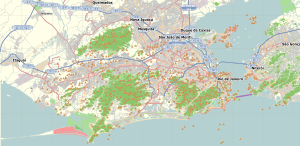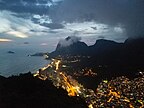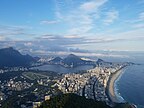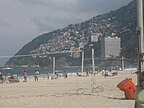
The Tijuca National Park is an urban national park in the mountains of the city of Rio de Janeiro, Brazil. The park is part of the Atlantic Forest Biosphere Preserve, and is administered by the Chico Mendes Institute for Biodiversity Conservation (ICMBio).

Rocinha is the second largest favela in Brazil, located in Rio de Janeiro's South Zone between the districts of São Conrado and Gávea. Rocinha is built on a steep hillside overlooking Rio de Janeiro, and is located about one kilometre from a nearby beach. Most of the favela is on a very steep hill, with many trees surrounding it. Around 200,000 people live in Rocinha, making it the most populous favela in Brazil.
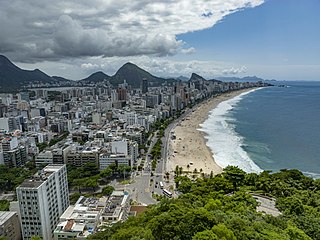
Leblon is a neighborhood of Rio de Janeiro, Brazil. It is also the name of the local beach. The neighborhood is located in the South Zone of the city, between Lagoa Rodrigo de Freitas, Morro Dois Irmãos and the Jardim de Alah channel, bordering the Gávea, Ipanema, Lagoa, and Vidigal neighborhoods. It is regarded as a very affluent area.
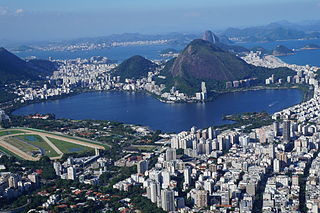
Lagoa is an affluent residential neighborhood in Rio de Janeiro, Brazil located around the Rodrigo de Freitas Lagoon. It borders the neighborhoods of Ipanema, Leblon, Copacabana, Gávea, Jardim Botânico, and Humaitá.

Hipódromo da Gávea, originally known as Hipódromo Brasileiro, is a horse racing course, located in the Gávea neighborhood in Rio de Janeiro, Brazil.
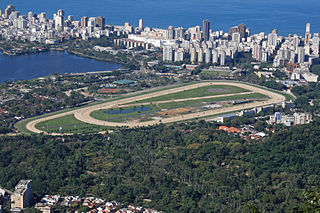
Gávea is an affluent residential neighborhood located in the South Zone of the city of Rio de Janeiro, Brazil. It borders São Conrado, Leblon, Lagoa and Jardim Botânico neighborhoods and is famous for its high concentration of artists. PUC-Rio, as well as several schools, are located in the neighborhood. Gávea is well known because of the "Baixo Gávea" area, which is considered a Bohemian quarter.
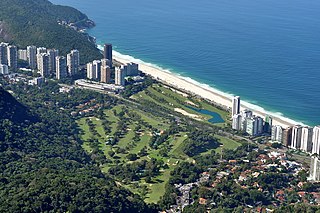
São Conrado is a neighborhood in the South Zone of the city of Rio de Janeiro, Brazil. It is nestled in between the neighborhoods of Barra da Tijuca to the southwest and Leblon to the northeast. The neighborhood takes its name from a small church, Igreja de São Conrado, which was constructed early in the 20th century by Conrado Jacob Niemeyer (1831-1905). São Conrado, which ranks as one of the areas with the highest Human Development Index in Brazil, presents a stark contrast to Rocinha on its border, which is one of the largest and poorest favelas in Brazil.

Tim Lopes was a Brazilian investigative journalist and producer for the Brazilian television network Rede Globo. In 2002, the media reported him missing while working undercover on a story in one of Rio's favelas. It was later learned that Lopes had been accosted by drug traffickers who controlled the area, was kidnapped, driven to the top of a neighboring favela in the trunk of a car, tied to a tree and subjected to a mock trial, tortured by having his hands, arms, and legs severed with a sword while still alive, and then had his body placed within tires, covered in gasoline and set on fire—a practice that traffickers have dubbed micro-ondas.

Crime in Brazil involves an elevated incidence of violent and non-violent crimes. Brazil's homicide rate was 21.26 per 100,000 inhabitants in 2021, according to the United Nations Office on Drugs and Crime (UNODC). In absolute terms, Brazil has the highest number of intentional homicides in the world with 57,358 in 2018, but adjusted for population, Brazil is in 18th place. In recent years, the homicide rate in Brazil has begun to decline. The homicide rate was 20.89 per 100,000 in 2019 with 43,073 killings, down from 30.59 per 100,000 with 63.788 killings in 2017. Some states had lower than a 10.0 homicide rate such as São Paulo with 8.4 and Santa Catarina 9.1 per 100.000.
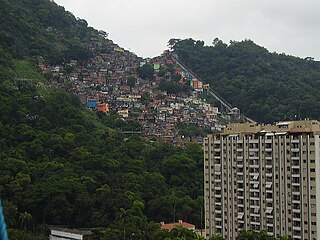
Favela Santa Marta is a favela located in the Botafogo and Laranjeiras part of the Morro Dona Marta, that is also divided with the neighborhoods of Flamengo, Cosme Velho and Silvestre, in the South Zone of Rio de Janeiro, Brazil. It has about 3,913 residents and 1,287 domiciles, with 500 wooden houses, 2,000 brick houses, 4 kindergartens, 3 bakeries, 2 sports fields, 1 block of a samba school, 3 military units and 1 small market. The favela is one of the steepest in the city, with an altitude of 352 metres (1,155 ft), approximately 45 degrees of inclination and occupies an area equivalent to 53,706 square metres (578,090 sq ft).

The South Zone is an area of the city of Rio de Janeiro situated between the Tijuca Massif, the Atlantic Ocean and Guanabara Bay. Most of it is made up of neighborhoods along the Atlantic coastline, such as São Conrado, Vidigal, Leblon, Ipanema, Copacabana, and Leme.
Line 4 of the Rio de Janeiro Metro is the third metro line built in the city of Rio de Janeiro. It was completed on 30 July 2016, connecting the Barra da Tijuca neighbourhood in the West Zone, passing under São Conrado and Rocinha, to Ipanema in the South Zone. All stations are underground, but when arriving in Barra da Tijuca, trains exit a tunnel, pass briefly by an elevated bridge and go underground again.
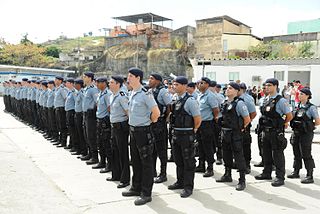
The Pacifying Police Unit, abbreviated UPP, is a law enforcement and social services program pioneered in the state of Rio de Janeiro, Brazil, which aims to reclaim territories, most commonly favelas, controlled by gangs of drug dealers. The program was created and implemented by State Public Security Secretary José Mariano Beltrame, with the backing of Rio Governor Sérgio Cabral. The stated goal of Rio's government is to install 40 UPPs by 2014. By May 2013, 231 favelas had come under the UPP umbrella. The UPP program scored initial success expelling gangs, and won broad praise. But the expensive initiative expanded too far, too fast into dozens of favelas as state finances cratered, causing a devastating backslide that enabled gangs to recover some of their lost grip.
Douglas Donato Pereira, also known as Dina Terror, was a Brazilian drug lord, who was killed in a shootout by Brazilian Police.

Cantagalo–Pavão–Pavãozinho is a neighborhood consisting of two favelas in the South Zone of Rio de Janeiro, Brazil. It is located between Ipanema and Copacabana. In 2010, it had about 9,500 inhabitants.

"Vai Malandra" is a song by Brazilian singer Anitta with fellow Brazilian singer Zaac and American rapper Maejor. The song features Brazilian producers Tropkillaz and DJ Yuri Martins. It was released as a single on December 18, 2017 and as the conclusion to Anitta's Check Mate project, where she releases a new song each month.
Brazilian militias, mainly in Rio de Janeiro, and some other cities of Brazil, are illegal mafia-like paramilitary groups made up of current and former police officers as well as Military Firefighters Corps officers, criminals, politicians, and military officers, operating also as a regular mafia by trade extortion and political influence.

The Vila Cruzeiro shootout took place on 24 May 2022 in the favela of the same name in Rio de Janeiro, during a joint operation by the Special Police Operations Battalion (BOPE), the Federal Police and the Federal Highway Police that resulted in at least 26 people killed by gunshots or cutting objects. It was the second most lethal police operation in the city of Rio de Janeiro, second only to the Chacina do Jacarezinho, which occurred a year earlier.

The armed conflict for control of the favelas in Greater Rio de Janeiro or simply Civil conflict for control of the favelas is an ongoing conflict between Brazilian militias, organized criminal groups Comando Vermelho, Amigos dos Amigos, Terceiro Comando Puro and the Brazilian state.

